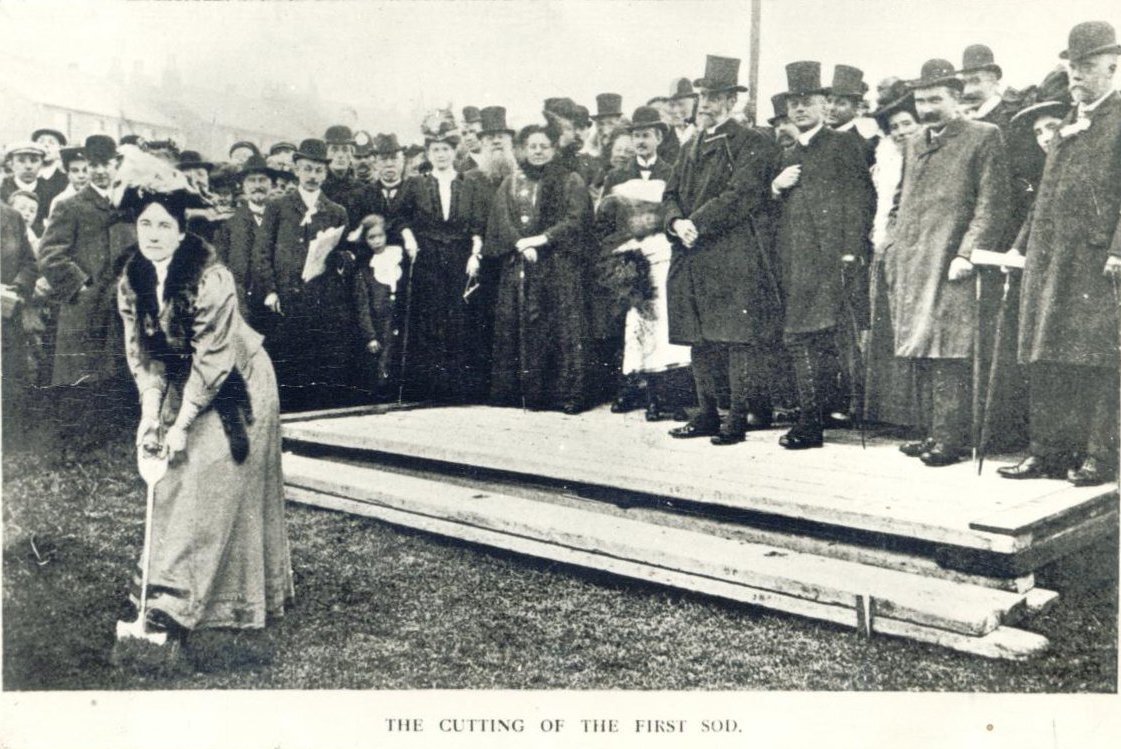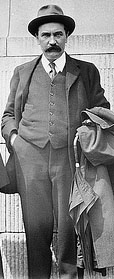|
Moor Pool History
In 1901, housing powers were delegated to a new Housing committee in recognition, at least, that there was a social problem. Its Chairman was Councillor J S Nettlefold, who opposed municipal housing and wholesale demolitions. Instead, his policy was to re-condition back courts by demolishing the two buildings on either side of a court entrance to allow more air and light to penetrate. These came to be called “Nettlefold Courts”. This policy of limited rehabilitation did produce some beneficial results, mainly through firm but friendly pressure upon the property owners so that a good deal of property was overhauled and repaired. The committee also saw a partial answer to the problem of the central slum area in encouraging the outward migration of the city’s population and it concluded that the average working man required better housing accommodation than he had in the past. The Housing Committee aimed to do everything possible to encourage and nothing to discourage a high standard of living and most significantly to encourage the exodus to the suburbs. In 1905, Nettlefold’s Housing Committee took a more radical look at the housing situation and a delegation visited Germany to examine the ways in which new houses had been planned and built there. The Committee’s basic problem was to find ways of improving inner area conditions as well as to assist in the provision of healthy, cheerful houses on the outskirts of the city, whilst at the same time not unduly or unnecessarily increasing housing rents. The German experience proved to have a considerable impact on the Committee’s thinking and some fairly advanced Town Planning principles emerged. The delegation found that every sizable town in Germany had adopted a Town Expansion Plan. This provided for the future development of all land within their boundaries setting direction and widths of streets and generally controlling the types of development in particular areas. This was a novel concept compared to the English experience of a haphazard methodology. Enthused by what they had seen, the Housing Committee recommended that there should be powers to control development in new areas to ensure a better distribution of houses and provision of roads, and to buy land in the suburbs where private enterprise could be encouraged to build working men’s houses at moderate rents. In moving in this direction, Birmingham was emerging as one of the first British local authorities to espouse Town Planning ideas, which have since been taken as basic principles influencing the type and direction of development. These ideas were soon to have legislative support in the Housing and Town Planning Act of 1909. Intent on proving that these radical ideas for town planning could work, Nettlefold took up an option on 36 and subsequently a further 18 acres of land to the north of Harborne. A Committee was set up for the formation of a Society on Co-partnership lines which became Harborne Tenants ltd. The company was founded to promote the erection, co-operative ownership and administration of houses on the lands at Moor Pool. Substantially built houses would be built and let at ordinary rents to pay a moderate amount of interest on the capital and to divide the surplus profits after expenses amongst the tenant members in proportion to the rents paid by them. Profits would be divided in shares. This had great benefits to the tenant but also provided a secure basis for capital funding for the Investors. To many at the time this was a radical concept and there was doubt that the Estate would be sufficiently viable to survive. They were proved wrong and the estate is celebrating the Centenary of the period it was built 1907-1912. Built with Harborne to one side and countryside stretching away on the other, Moor Pool was indeed radical. It contrasted starkly with the back-to-back housing within the City and was built to show an alternative way forward. The arrangement of the roads and houses worked with the undulating contours of the land and provided a range of community facilities unheard of elsewhere in the City. The gardens and allotments provided a much healthier environment with mortality rates far lower than the City. In addition to the open space considered so important by Nettlefold, other facilities were provided including Moor Pool Hall with stage and basement skittle alley, a rifle range (used by the Home Guard during World War II), a billiard hall, reading rooms, library, tennis courts, bowling green and village green. Clubs and associations included the Coal Club, Athletic Club, Bowls Club, Cycling Club, Horticultural Society, Musical and Dramatic Society, Social Club, Tennis Club, Provident Society and the Moor Pool Supply Association. Moor Pools roads were narrower than the norm at 16’ width, this being considered adequate for the amount of traffic. Instead space was given over to grass verges and front gardens. To allow this, an exemption was required from the restrictions of the byelaws at the time. The open space between the houses and behind, all contributed to better airflow and a healthier environment. As Birmingham grew the lands surrounding Moor Pool were developed leaving this unique enclave which has survived remarkably intact to this day. As an example of community planning Moor Pool is still an example to aspire to with perhaps the narrow roads the only feature at odds with the demands of modern life. In his opening address at the sod cutting ceremony on the 26th October 1907, Dr William Gore said:
“They were perfectly conscious that the housing problem lay at the very root of social reform. There must be better houses, more room, more gardens and more open spaces for the children. The Harborne Tenants aspired to provide houses under these conditions within the means of workmen and artisans……..These houses were to be suitable for bringing up healthy children and healthy men and women. It would be an example of town-planning……..They had set an example of what could be done in the way of town planning on a voluntary basis. They were going to make an Edgbaston for the less wealthy class on that spot”.
“They would watch this experiment in Birmingham with interest for it would have its influence all over this great district.”
The Right Hon William Kenrick had the following comment:
“They wanted the City Councillors and urban district councils to have the power to say to building speculators:’ “You shall not crowd houses irrespective of decency and the health of the children and the inhabitants of the houses.”
Further information on the formation is available in the document ‘Founding of the Harborne Tenants Estate’ The original prospectus for the estate referred to the architects Martin and Martin:
‘Messrs Martin and Martin are the Society’s Architects. The plans produced by them have been highly praised by experts in the Garden City movement’.
The cutting of the first sod was carried out by Margaret Nettlefold, the silver spade being recently used by the Moor Pool Players in their re-enactment of the great event. 
 Nettlefold, wrote at least 2 books on the subject of town planning ‘Practical Town Planning’ (21mb) and ‘Practical Housing’ (15mb) both of which clearly indicate his views and reasoning behind the Moor Pool development. Nettlefold, wrote at least 2 books on the subject of town planning ‘Practical Town Planning’ (21mb) and ‘Practical Housing’ (15mb) both of which clearly indicate his views and reasoning behind the Moor Pool development.
More recently Sir Nikolaus Pevsner the eminent architectural historian had this to say about Moor Pool:
‘An important and early example of the work of a co-partnership building exercise is the estate which was developed in about 1908 by Harborne Tenant Ltd…...The housing is as enterprising as any in the country and strongly influenced by Unwin’.(1)
In 1994 Harborne Tenants Ltd was taken over by BPT. Subsequently the BPT plc group of companies including BPT (Residential Investments) Ltd was taken over by Bromley Property Investments Ltd. Finally In 2003 the BPT companies were taken over by Grainger plc. The background to this was covered in an article in Property Week, December 2001. Harborne Tenants Ltd the registered owner of the balance of the Estate remains part of BPT (Residential Investments) Ltd which is a wholly owned subsidiary of Grainger Plc. Sadly Grainger have failed to recognise Moor Pools historical importance and have plans to build houses on the open spaces so important in Nettlefolds vision. (see Moorpool Regeneration Group web site for further information)
(1) Ref: The Buildings of England. Warwickshire. Other references: Birmingham’s Built Environment in the Twentieth Century. |
 Mr Henry Vivian, M.P. Chairman of Co Partnership Tenants Ltd said
Mr Henry Vivian, M.P. Chairman of Co Partnership Tenants Ltd said